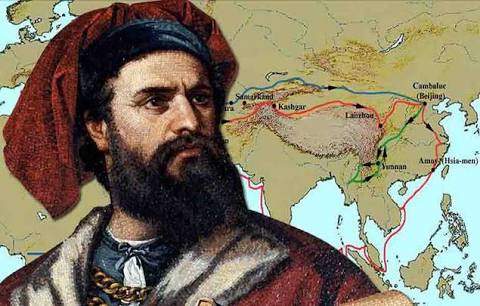They were hard put to complete the journey in 3 and a half years, because of snow and rain and flooded rivers and violent storms in the countries through which they had to pass, and because they could not ride so well in winter as in summer.
.jpg)
Marco Polo
Towards the end of the 13th century, the traveller Marco Polo returned to his native Venice after an extended stay in China. Although this summary of his journey overland from Europe to China implies considerable hardship, Polo never complained of robbers, official extortion, tough terrain or bureaucratic delays to the other merchants that he primed to travel the route. Instead he focused his anxieties on the treacherous deserts.
One of these was Taklimakan, the desert north of Tibet. Here, caravans paused on the edge of the desert for a week's refreshment and stocked up with a month's provisions. As a rule, the bigger the caravan, the safer, but no more than 50 men and their beasts could hope to be sustained by the modest sources of water they would find over the next 30 days.
The voices of spirits across the sand
The worst danger of desert travel was getting lost, lured from the path by demon spirits and sandstorms were seen as a demon's device to disorientate the travellers. The Mongols recommended warding them off by smearing the horses' necks with blood. 'Even by daylight men hear these spirit voices and often you fancy you are listening to the strains of many instruments, especially drums, and the clash of arms,' wrote Polo. 'Bands of travellers make a point of keeping very close together. Before they go to sleep they set up a sign pointing in the direction in which they have to travel. And around the necks of all their beasts they fasten little bells, so that by listening to the sound they may prevent them straying off the path.'
Although individual travellers favoured horses, merchants relied on camels to carry their wares, each laden with bundles weighing up to 500 lbs or 225 kg. The camels could travel much farther than horses without regular food and water, and their soft hoofs did not sink into the sand. As the route was long and arduous, merchant caravans carried small quantities of high-value goods, and kept to routes between the Tien Shan and Kunlun mountains, where there were oases and settlements.
Independent travellers to China- who included merchant's couriers, missionaries and ambassadors- could travel safely under Mongol protection along a sparsely inhabited steppeland route to the north. The discomforts, however, were daunting : extremes of temperature, long periods of hunger and thirst, and stretches where the only fuel for fires, if any, was horse dung.
The great obstacle on this route was the Alti Mountains, crossed in two-day stages between iams-military way-stations- where travel weary guests could sleep and the horses changed for fresh ones.
Images: 1

I have been watching Marco Polo on Netflix. Historical accuracy takes a back seat to entertainment value but it is a good story.
Downvoting a post can decrease pending rewards and make it less visible. Common reasons:
Submit